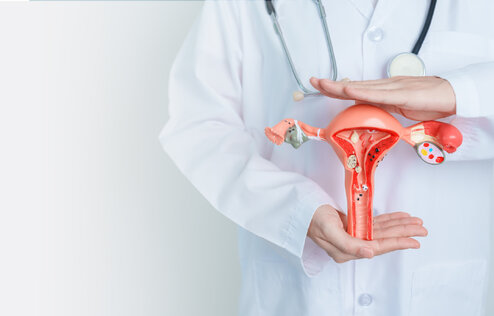Most Common Gynecological Diseases
Center : Women Health Center

Choose to read by topic:
Gynecological diseases are conditions that should not be ignored. Women of reproductive age are at risk of developing these problems. Gynecological conditions are varied. There are many symptoms that may relate to the conditions, such as abnormal vaginal bleeding, heavy cramps between periods, or spotting after menopause. It is recommended that women should regularly have physical examinations, mainly to prevent gynecological problems before it’s too late.
What is Gynecological Diseases
Gynecological diseases are defined by diseases of the female reproductive organs: the vagina, the cervix, fallopian tubes, the uterus, and the ovaries. Gynecological problems directly affect women’s quality of lives, specifically reproductive health and fertility. It is noted that gynecological conditions are varied, such as cyst, fibroid, cancer, pelvic inflammation, etc.
1. Uterine Fibroid
One of the most common gynecological problems is uterine fibroid. With the prevalence of approximately 25% of women aged 35 or older, some women who have uterine fibroid may experience no symptoms at all. It is important to learn more about this common condition.
What is Uterine Fibroid
Uterine fibroid is a growth that appears in the uterus. It may have one or many lumps, depending on the condition. The fibroid is also varied in size. The fibroids can either be slow-growing or fast-growing. Most of the time, uterine fibroid is coincidentally found during a physical examination,
Uterine Fibroid Symptoms
Most women who have uterine fibroid experience no apparent symptoms; however, there are some signs and symptoms indicating the condition. Such symptoms are increasing vaginal discharge, abdominal pain, urinary retention, menorrhagia, longer menstrual cycles and bleeding more than usual. Sometimes, women with uterine fibroid may have tumors in the lower abdomen as well.
2. Chocolate Cyst
Chocolate cyst is considered one of the most prevalent gynecological conditions in women of childbearing age.
What is Chocolate Cyst
Chocolate cysts are ovarian cysts filled with menstrual blood. They are a sign of endometriosis, a normal condition that happens every menstrual cycle. They are also varied in size. Chocolate cyst is sometimes considered to affect fertility.
Chocolate Cyst Symptoms
Examples of chocolate cyst symptoms are:
- Dysmenorrhea (pain during period)
- Pelvic pain
- Pain during sex
- Back pain or no symptoms
3. Bacterial Vaginosis
Gynecological problems also include bacterial vaginosis. Women can have bacterial vaginosis at any age. The exact causes are still unknown, but certain activities increase risks of developing the condition.
What is Bacterial Vaginosis
Bacterial Vaginosis is a type of vaginal inflammation caused by bacterial infection. The normal flora, bacteria naturally found in the vagina, overgrow and result in inflammation.
Bacterial Vaginosis Symptoms
Generally, bacterial vaginosis symptoms include vaginal itching, burning during urination, fishy vaginal odor, and thin, gray or greenish vaginal discharge. Some women may experience no signs or symptoms at all.
4. Dysmenorrhea
Dysmenorrhea (Menstrual cramps) is also one of the most gynecological problems in women. The degree of discomfort varies, depending on each person.
What is Dysmenorrhea
Dysmenorrhea is a sensation of throbbing or cramping pain in the lower abdomen. Most women have cramps the first day of their menstrual period, whereas some women may experience the pain the whole duration of the period. Sometimes, dysmenorrhea may be caused by endometriosis as well. Hence, it is recommended that you seek professional advice to precisely diagnose and get a proper treatment.
Dysmenorrhea Symptoms
Dysmenorrhea symptoms usually include throbbing or cramping pain in the lower abdomen, dull or continuous ache, radiating pain to the lower back or legs, and pain that starts 1-3 days before the period with peak in the first 24 hours after the onset of your menstrual period.
5. Polycystic Ovarian Syndrome
Another common gynecological disease is polycystic ovarian syndrome (PCOS). The exact causes of PCOS are still unknown. There are many factors contributing to the risks of PCOS.
What is Polycystic Ovarian Syndrome
Polycystic Ovarian Syndrome is a condition concerning the hormones. It is common in women with reproductive age. One of the most distinct characteristics of PCOS is that many small sacs of fluid develop along the outer layer of the ovary. These sacs are called cysts, containing immature eggs.
Polycystic Ovarian SyndromeDysmenorrhea Symptoms
Symptoms of PCOS usually start approximately the time of the first menstrual period. In some cases, symptoms may develop later in life. Common symptoms of polycystic ovarian syndrome are irregular periods, too much androgen, and polycystic ovaries. Some people may experience additional symptoms, such as
- Irregular period, sponge.
- Increased period intervals of the absence period.
- Acne, oliy skin.
- Excessive weight gain.
Conclusion for Gynecological Diseases
Abnormal vaginal discharge can indicate gynecological diseases. Its colour and texture is important in determining whether it is normal or unusual. Other signs and symptoms, such as itching around the vagina, irregular bleeding, and lower abdominal pain, can indicate gynecological problems as well. It is recommended that you seek professional advice if you have aforementioned symptoms.
Online Consultation
Article of Women Health Center





